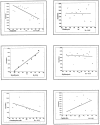Antimicrobial drug use and resistance in dogs
- PMID: 11842592
- PMCID: PMC339174
Antimicrobial drug use and resistance in dogs
Abstract
Fifteen years (1984-1998) of records from a Veterinary Teaching Hospital were analyzed to determine whether antimicrobial drug resistance in coagulase-positive Staphylococcus spp. (S. aureus, S. intermedius) isolated from clinical infections in dogs has increased, and whether there has been a change in the species of bacteria isolated from urinary tract infections in dogs. In coagulase-positive Staphylococcus spp., a complex pattern showing both increases and decreases of resistance to different classes of antimicrobial drugs was observed, reflecting the changing use of different antimicrobial drug classes in the hospital over a similar period (1990-1999). In canine urinary tract infections identified from 1984 to 1998, an increase in the incidence of multiresistant Enterococcus spp. was apparent, with marginal increases also in incidence in Enterobacter spp. and in Pseudomonas aeruginosa, both of which, like Enterococcus spp., are innately antimicrobial-resistant bacteria. A survey of directors of veterinary teaching hospitals in Canada and the United States identified only 3 hospitals that had any policy on use of "last resort" antimicrobial drugs (amikacin, imipenem, vancomycin). Evidence is briefly reviewed that owners may be at risk when dogs are treated with antimicrobial drugs, as well as evidence that some resistant bacteria may be acquired by dogs as a result of antimicrobial drug use in agriculture. Based in part on gaps in our knowledge, recommendations are made on prudent use of antimicrobial drugs in companion animals, as well as on the need to develop science-based infection control programs in veterinary hospitals.
Figures



References
-
- Wegener HC, Aarestrup FM, Gerner-Smidt P, et al. Transfer of antibiotic resistant bacteria from animals to man. Acta Vet Scand 1999;92 (Suppl):51–57. - PubMed
-
- Van den Bogaard AE, Stobberingh EE. Antibiotic usage in animals. Impact on bacterial resistance and public health. Drugs 1999;58: 589–607. - PubMed
-
- Sternberg S. Antimicrobial resistance in bacteria from pets and humans. Acta Vet Scand 1999;92 (Suppl):37–50. - PubMed
-
- Schwartz S, Noble WC. Aspects of bacterial resistance to antimicrobials used in veterinary dermatological practice. Vet Dermatol 1999;10:163–176. - PubMed
-
- Oluoch AO, Weisger R, Siegel AM, et al. Trends of bacterial infections in dogs: characterization of Staphylococcus intermedius isolates (1990–1992). Canine Pract 1996;21(2):12–19.
MeSH terms
Substances
LinkOut - more resources
Full Text Sources
Medical
Miscellaneous
